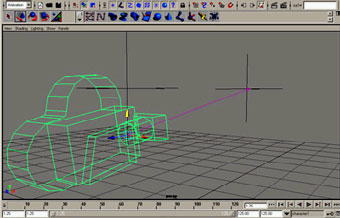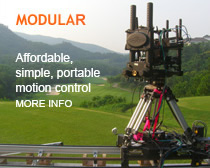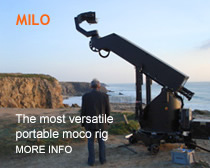- EQUIPMENT
- Motion Control Rigs
- Bolt
- Milo
- Long Arm Milo
- Modular Rig
- Friction Drive
- OUR WORK
- FEATURE FILM CREDITS
- IMPORT/EXPORT
- STAGE
MOTION CONTROL

Importing data into motion control from CG or exporting the shot camera move into the CG system is becoming more and more popular and commonplace. Both of these data transfers involve taking a 3 dimensional move from one world into another. They each introduce their own challenges, but are intrinsically simple procedures that Camera Control has done numerous times and we are possibly the most experienced at this of any Motion Control Company.
A write up of some of the issues that can be encountered importing data into CG may be downloaded here. Many of these issues are addressed right here on this web page.
The Data format used by Flair for exporting and importing may be downloaded here.
Some issues are common to both operations and these are:
Scaling
The move in a motion control system is in "real world" space. This means that if the camera starts 4 feet above the floor and ends at 8, that is the data that will be in the file. The CG world scale is totally arbitrary and I have seen doors modeled at 6 units high where the units are centimeters and thus nothing is going to match the real world. So it is vital for both import and export that the modeling be done in actual sensible units. You can use feet, inches or whatever, but the modeled items should be the right size.
Orientation and Translation Offsets
The only real commonality between the CG system and the Motion control system is that Up is Up. Left, Right, Forwards and Backwards are totally dependent on how the models are lined up and how the rails are laid down in the stage. You do have to establish the relative orientation of the axes and some translation offsets that may exist between the systems. (The translation offsets have to do with where 0 is determined to be in the 2 worlds. Often the floor is zero in height, but not always). Both the Orientation and the translation offsets are best resolved by a Line Up or Reference move.
Line Up or Reference Move
A Line Up move is a camera move (real or CG) on an object that will exist in both worlds. For example: If you wanted to shoot a table in the real world and add a CG object to it, you need to know where the table is and how it is oriented up in moco space. If you take the motion control camera and line up the cross hairs onto one corner, and then move across to another corner and export that motion, you can get definite data on where the table is in moco space and this will tell you how to convert it into the world space of the CG Camera. Flair Motion Control software natively works with a target, and a move like this exported with a target, not only gives the camera position, but also where the target is, and the target point can be used to EXACTLY match the 2 worlds together. The size of the move will also be useful for ensuring that the scale between the 2 systems is correct. If you are not using a target system when this data is exported, then you either have to record the data of how far away the target is or use triangulation on each point and this gets more complex.
Lining it up
Of course, a line`up on video or a line up on film only gives you the position of the object on the screen left/right and up/down, it does not give you how far away the object is. If the object appears too small, this can be corrected by moving the camera closer, changing the focal length, or adjusting the image size (gate size). Once you depart from doing something correctly using the exact data you have and start matching by eye, you have abandoned using the data any more and have gone into the realm of match moving. Whilst it is very temping to fudge it around by eye as it will make it look better right away, the moment you do that, you are committed to doing only that. Using the target distance in the flair system and importing/exporting this data, you can get the exact distance that the camera is supposed to be from the object and so make sure your line up is perfect. Note that the distance from a camera to an object in the CG world is almost always from the front nodal point of the lens - and so is it with a real camera. Flair will automatically convert a nodal distance into a focus distance when the lens is correctly set up.
Recent Projects
Snow White and The Huntsman
James Bond: Skyfall
Jack the Giant Killer
Hugo
Ed Sheeran "Small Bump"
The Muppets
Sherlock Holmes:
A Game of Shadows
Petronas Formula One
EbayMcLaren
BP
NatWest Bank
Lana Del Rey "Born to Die"
Barclaycard
Cartier
Rolex
Virgin Money
Pepsi
47 Ronin
Join our mailing list
Showreel
Available soon


